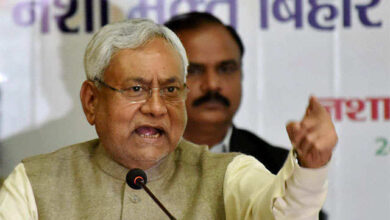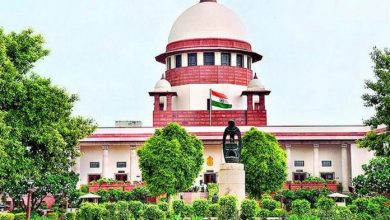UK to review current Hate Laws
Asad Mirza
Recent reports reveal that the UK has decided to review its hate laws. Earlier, under these laws the UK had barred Indian televangelist Zakir Naik from entering the UK in 2010. There are reports that a former head of British counter-terrorism unit will lead a review for a new law to stop hate behaviour and preaching through social gatherings or using social media platforms.
In addition to ban Zakir Naik from entering the UK earlier, recently his Peace TV channels have also been fined for airing hate speeches, as per the sources and these latest actions have prompted a review into UK hate laws.
Dr Naiks Islamic Research Foundation (IRF) runs two television stations, Peace TV and Peace TV Urdu, which were fined £300,000 in June by the UKs media regulator, OfCom, for broadcasting hate speeches and incitement. Further, an investigation has also been launched into the charity he founded that funded them.
Action against Peace TV
Dr Naik was barred from entering the UK by former UK prime minister Theresa May when she was the home secretary, over inflammatory remarks he had previously made in speeches in India. But his channels continued to operate. UKs Commission for Countering Extremism (CCE) last month cited Dr Naik’s channel as an example of Islamist extremism, which has led to a review of the powers available to the authorities to take action against acts of hate. According to a statement, the CCE believes there are gaps in the old law allowing extremists to sow divisions in the society and are looking into whether a new law could be introduced. This review is supposed to make the law tougher and seal any loopholes in the earlier version.
In the recent OfCom ruling against Dr Naiks television stations, it was found that four programmes breached broadcasting rules on incitement to commit crime, hate speech, abuse and offence after they aired lectures that described people worse than animals and advocated the execution of magicians. OfCom also ruled that the broadcasts were very serious and could encourage vulnerable viewers to commit killings.
The Charity Commission of the UK is currently investigating the operations of Dr Naiks charity, the Islamic Research Foundation International. Dr Naik, who is based in Malaysia, has also been barred from travel to India and Bangladesh. Both countries accuse him of inspiring terror acts. Dr Naik is also accused by the Indian government of laundering £23 million (Dh107m).
CCE Review
According to CCE, its legal review, which will be led by the former head of British counter-terrorism unit, Sir Mark Rowley, will examine the evidence of abuse it has found that is not covered under current UK terrorism legislations or hate laws. Sir Mark will be looking at existing laws and how they are used to see if a new law could be created, and will report his findings later in the year.
According to reports the commission has found evidence of a number of incidents where hateful behaviour happened but failed to meet the threshold to be considered a crime under the current law, not only from Dr Naik but also by Haitham Al Haddad of the Muslim Brotherhood’s Islamic Council of Europe.
The commission has identified recent extremist far-right posts related to infecting people with coronavirus on social media platforms such as Gab and 4chan. These channels have been used by terrorists including Christchurch attacker Brenton Tarrant, who murdered 51 people in two mosques.
“Hateful extremism threatens our ability to live well together, Sara Khan, the controversial head of the CCE said in a statement, “and many extremist actors and organisations, whether far-right, Islamist or other, continue to operate with impunity in our country, both online and offline. The CCE was launched in March 2018 after the London Bridge terrorist attacks in 2017.
UKs Prevent Strategy
What is happening is not new; the Prevent strategy is one strand of the UK counter-terrorism strategy, CONTEST. It was introduced in 2003 by the Labour government of Tony Blair. Initially, Prevent played a minor role in CONTEST relative to the other strands. But following the attacks in London on 7th July 2005, the importance of the Prevent strategy increased as the government sought to deal with a risk of home-grown terrorism.
Under the strategy, the problem of extremism and terrorism is closely tied to Muslims and Islam, so that the terror threat is regarded as an Islamic threat. Although the policy document does refer to other groups and forms of terrorism (such as right wing terrorism), the thrust of the policy is about Islamic terrorism. Furthermore, its emphasis on teaching British values suggests its focus is on those who do not authentically practice Britishness.
Framing the threat in this way not only othered Muslims, but the otherness has narrowed the public perception of Muslims linked closely to terrorist violence and have increasingly inscribed the characteristics onto the public consciousness, further normalising Islamophobia. This normalisation augmented the states ability to use enhanced forms of social control, exclusion and violence against Muslim communities.
Contrary to official denials, surveillance forms an essential article of the Prevent strategy. It regarded radicalisation as part of a larger roadmap to terrorism, and thus attempted to control the future by acting in the present. The terror threat emphasised the war on terror, as an Islamic threat, which called for a surveillance infrastructure, embedded into Muslim communities.
Before Prevent came into existence, the British government had propagated Engaging with the Islamic World (EIW) programme.
The EIWs aim was to challenge and change perceptions of the UK in the ‘Muslim world at home and abroad’ and to project Britain ‘as modern, multicultural and tolerant’. The EIW not only aimed to promote understanding of British foreign policy abroad, but also had a domestic role in tackling extremism and building an understanding of Islam in Britain.
Flaws of Prevent and EIW
However, both the Prevent and EIW programmes lacked a clear understanding of the issues involved and correct identification of key players, who could have played a positive role in the development of anti-terror strategies. EIW, unduly stressed image making through promoting successful British Muslims, while the Prevent encouraged surveillance involving young people. Both programmes lacked any connect with community leaders and religious figures and were thus abhorred by the community and labelled as hand tools of increasing Islamophobia.
Instead of contextualising the issues or understanding the real meaning of the so-called hate speeches the analysts interpreted them literally, as they had no background either in the languages or the psychology or the ethos of the communities or speakers under surveillance and ultimately gave a twisted version to appease their political masters, instead of using the same money judiciously in nurturing institutions or individuals, based in the Arab world or India who could have provided a much needed sagacious advice.
The Arab or Indian religious leaders had a key role to play in these programmes, as a large percentage of British Muslims are of Arab and Indian origin, but they were ignored either due to the ignorance or deliberately. Though the Imams and religious leaders based in Britain had a better connect with the community, but their influence paled in comparison to the leaders based either in the Arab world or India, on the Muslim community in the UK. In real terms the official programmes were unable to sort the disconnect between the communities and ignorantly sponsored disconnect instead of promoting cohesion within the British society with the help of Arab and Indian influencers of stature.

(Asad Mirza is a Sr journalist and commentator based in New Delhi.
He was also associated with BBC Urdu Service and Khaleej Times of Dubai.
He writes on Muslims, educational, international affairs, interfaith and current affairs. )





